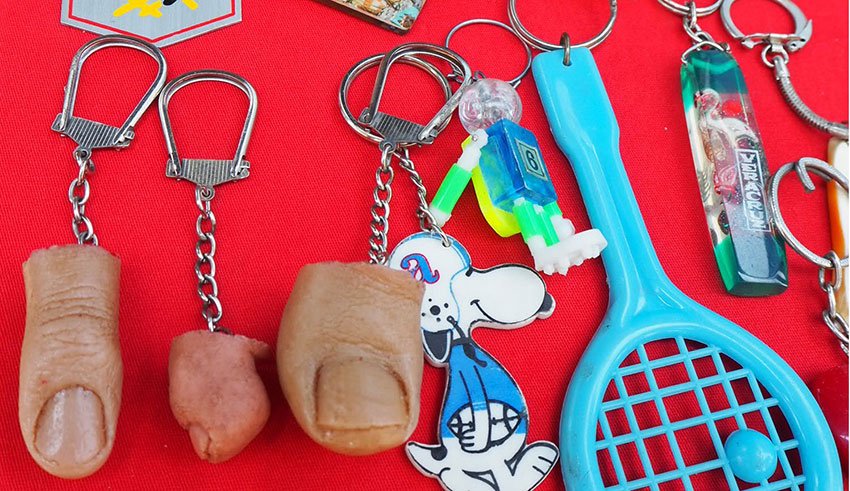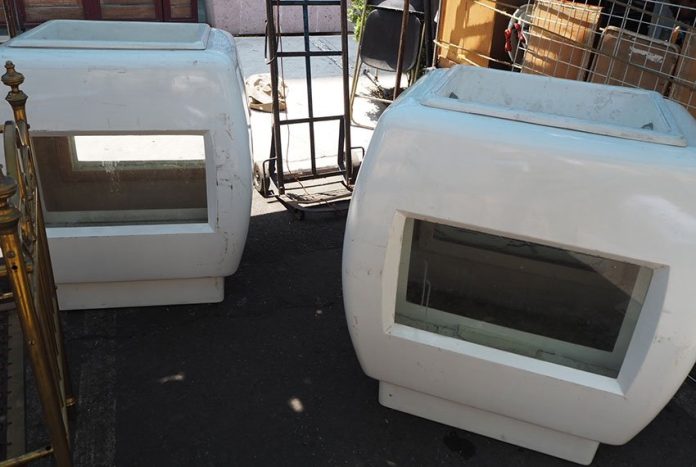Chácharas – trinkets, knick-knacks, curios, bric-a-brac, junk or simply, stuff – are the talk around Tianguis de la Portales in the northern end of Mexico City’s Colonia Portales.
They say one man’s trash is another man’s treasure, and they have, perhaps, said this more than anything else about the Portales Antiques Flea Market.
But if you’re a sucker for tiny collectables like pewter animals, pins, wick lighters and decorative tins, then Tianguis de la Portales is the place for you. A severed toe key ring for 70 pesos? Sure. Why not.
Portales’ short, one-block flea market isn’t consistently the best antiques market in the city, but it’s open every day and there are still plenty of gems to keep regulars coming back. It’s like a giant garage sale spilling out on to the street and worth a special stop or a quick visit whenever you find yourself around the neighborhood.
Piles of used clothes beg to be dug through in search of the valued label here and there. Used washing machines and refrigerators, tools, some beautiful furniture (and much of questionable value) – you could furnish an entire house from this block of Calle Rumania, though its presentability may depend on the day you arrive.

Many passing through appear to be book collectors, hoping to eye some 100-year-old title that may have snuck by the vendor’s watch.
The street market opens at 8:00am, but sales don’t get into full swing until around 11, so it’s delightfully reasonable to arrive around midday, unless you’re an antiques shark who wants to be the first to see each new product.
Some of the most amusing pieces are the electronics and appliances from the 60s, 70s and 80s that quickly anachronized with the changing times, like the enormous ice chests for 2,000 pesos that no one really understands how to use.
Or a cassette and LP boombox that the vendor assumes is in working condition but doesn’t have the proper power cord to plug it in – it’s going for 300, but she’ll give it to you for 200.
Roberto Aguilar tells me he’s been selling for 37 of the approximately 70 years the street market has been running here. He doesn’t specialize in anything, kind of whatever comes by, and usually gets his items in bulk lots when someone sells their house. “Or [when] a lot of people are dying, too,” he says.
Most of the vendors say that framed pictures, lamps and light fixtures are the most sought after by clientele, although the latter seem to be in short supply today. There are boxes of old photos to sift through for an imagined guess into the lives of the long dead, shoes, handbags, weird and creepy figurines, typewriters and a number of collectible toys.

Marcos Maldonado’s stand goes a bit more down the path of the legitimate antiques dealer: watches, jewelry, eyeglasses and pins from the mid to early 20th century. He reckons his oldest items are the clothing irons from around 1900 that are priced between 400 and 800 pesos (US $21 – $42).
He gets his product everywhere from metal recyclers pulling carts in the street to his personal clients that are always on the lookout for special items. But the estate sales are where the good money is because you can buy an entire room full of items, or an entire house.
Sometimes a particularly valuable piece of jewelry will come up, and he recalls once buying a huge panoramic photo of Mexico City from around the time of the Revolution. He made a lot of money on that one.
Portales is a great place for the vintage audiophile, with used stereo equipment for fairly cheap, as the home stereo goes the way of the typewriter. Giant name brand speakers from the 80s and 90s for 500 to 1,200 pesos – a great deal provided they work, as promised – and used records in good shape for 20 to 30 pesos.
Around the corner on Libertad are some of the nicer jewelry pieces and antique home goods. Intricately hand-carved vintage ivory earrings for 400 pesos seems to be a reasonable deal. Some vendors keep their truly special items hidden away, awaiting the collectors.
Vintage shop owners pass through, searching for the hip item du jour to fill their shelves. And new product continues to arrive throughout the afternoon, as cars pull up to their chosen vendors and open their trunks to show the goods. You can make a few passes and see something new each time.

Maria de Jesús Romer sells out of a garage she rents on Rumania, as do many vendors. It must be quite the time saver not to have to drive the product in every day. She tells me sales have gone down the past couple of years.
“It used to be people looking for finer stuff, more antiques,” she says. “At the same time, it’s hard to find good stuff these days, real antiques. Because a lot of people have passed away or given their antiques to their children,” thus making room for the glut of DVDs, computer monitors, scanners and VHS players – the antiques of tomorrow.
Due to all the vendor traffic and traffic from the nearby Mercado Portales, it’s worth taking public transportation or walking to avoid the mess.
After the tianguis walk a few blocks to the enormous Bazar Reto showroom (Fernando Montes de Oca 391) for the beautiful antique furniture. It’s a bit pricier but in great shape. And there are plenty of chácharas to wade through upstairs.
• Tianguis de Antigüedades de la Portales is located on Calle Rumania, between Libertad and Calzado Santa Cruz, Colonia Portales/San Simón, open Monday – Friday, 8:00am to 6:00pm.
This is the 12th in a series on the bazaars, flea markets and markets of Mexico City:
- Mercado Martínez de la Torre one of the best food markets in Mexico City
- Choose your adventure of history, gastronomy or art at Saturday Bazaar
- Collected artistic traditions of Mexico are under one roof at this city market
- Sharpen your bargaining skills at the best little antiques market
- Mexico City’s most colorful market is Mercado Jamaica, the flower market
- You’ll find art at Mercado Coyoacán, but the main attraction is food
- MercadoRoma, a Mexican public market reimagined for the 21st century
- Tuesdays in Taxqueña, the flea market of musical brotherhood
- Escandón Market is quintessential middle-class CDMX neighborhood market
- A walk through the Mexico City markets of Colonia La Condesa
- The San Juan market, Mexico City’s epicenter for culinary inquisition
